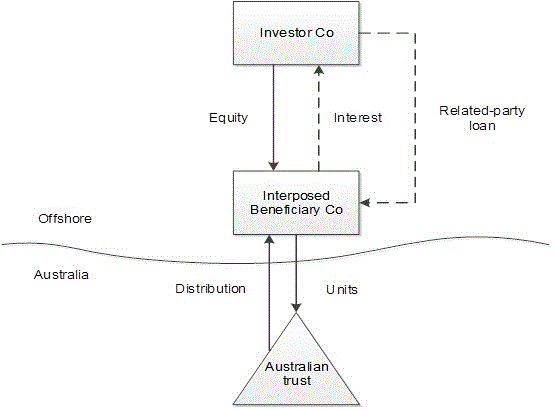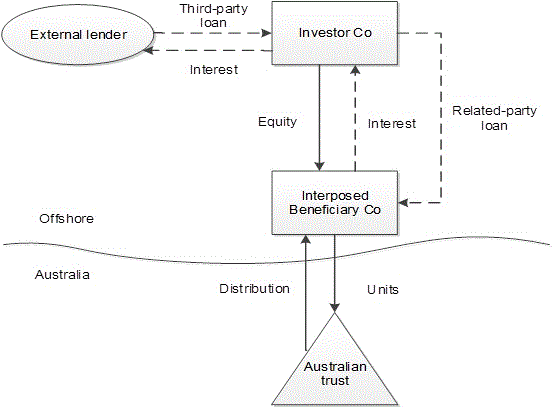Taxpayer Alert
TA 2020/3
Arrangements involving interposed offshore entities to avoid interest withholding tax-
This document incorporates revisions made since original publication. View its history and amending notices, if applicable.
| Alerts provide a summary of our concerns about new or emerging higher risk tax or superannuation arrangements or issues that we have under risk assessment.
While an Alert describes a type of arrangement, it is not possible to cover every potential variation of the arrangement. The absence of an Alert on an arrangement or a variation of an arrangement does not mean that we accept or endorse the arrangement or variation, or the underlying tax consequences. Refer to PS LA 2008/15 for more about alerts. See Alerts issued to date. |
Description
We are reviewing arrangements which use offshore related entities to facilitate the avoidance of a withholding tax liability in relation to interest expenses deducted against Australian-sourced income and paid to non-residents.
The arrangements involve a non-resident deriving Australian-sourced income and incurring interest expenses (commonly from debt sourced from a related party) deductible against that income.
Relevant arrangements typically display some or all of the following features:
- •
- an Australian resident flow-through trust with one or more non-resident investors
- •
- the non-resident investor holds its interest in the resident trust through an interposed offshore entity (usually in a third jurisdiction which is a low or no tax jurisdiction and which is not part of the Australian tax treaty framework)
- •
- the interposed beneficiary is financed in part or in whole by (usually, related-party) debt
- •
- the interest rate on the debt is at a significant premium to referrable third-party debt, or the lending entity's cost of funds (and the arrangement would usually fall outside the 'green zone' referred to in PCG 2017/4[1])
- •
- the resident trust derives Australian-sourced income and makes distributions to the interposed beneficiary
- •
- the interposed beneficiary deducts the interest expense against the Australian income it receives from the trust.
We are not concerned with structures where deductible interest payments by a non-resident are merely incidental to what can be evidenced as ordinary and commercially appropriate business decisions.
Example arrangements
Example 1 - deduction claimed by interposed non-resident beneficiary on related-party loan

Description
A resident trust derives income which the trustee distributes to an offshore interposed beneficiary, with the trustee paying tax on the distribution at the corporate rate pursuant to subsection 98(3) of the Income Tax Assessment Act 1936 (ITAA 1936). The beneficiary is partially funded with high interest rate related-party debt, usually with no traceable third-party debt. This creates significant interest deductions for the beneficiary against its Australian income in the tax return, giving rise to a refundable credit for all or almost all the tax already paid by the trustee. The non-resident beneficiary is claimed not to be carrying on business through a permanent establishment in Australia.
Consequences
The purported effect of the arrangement is that the interposition of Beneficiary Co enables the related-party debt to be located offshore so that no interest withholding tax liability arises while a significant amount of interest deductions is claimed against the assessable Australian income.
Example 2 - deduction claimed by interposed non-resident beneficiary on related-party loan

Description
A resident trust derives income which the trustee distributes to an offshore interposed beneficiary, with the trustee paying tax on the distribution at the corporate rate pursuant to subsection 98(3) of the ITAA 1936. The interposed beneficiary is largely funded with a related-party loan priced at an excessive margin above relevant third-party loan, with a principal amount substantially more than that of the third-party loan. The beneficiary deducts interest expenses against its Australian income, with no liability to interest withholding tax arising, as in Example 1 of this Alert. A refundable credit for any tax paid by the resident trustee is claimed by the beneficiary.
Consequences
The purported effect of the arrangement is that non-arm's length interest deductions (from both quantum and pricing perspectives) are claimed by the offshore beneficiary to offset its assessable Australian income, while avoiding interest withholding tax liability.
What are our concerns?
We are concerned that these arrangements may be entered into to avoid interest withholding tax liability.
We are particularly concerned about arrangements displaying some or all of the following features:
- •
- There appears to be no commercial rationale other than tax reasons to support the interposition of a non-resident beneficiary and/or the jurisdiction of that beneficiary.
- •
- There appears to be no commercial rationale other than tax reasons why the debt used for Australian business purposes should be borne by the non-resident beneficiary.
- •
- The effective tax rate on Australian-sourced income is minimal or zero.
- •
- The related-party debt is at a significant premium to referrable third-party debt, or the lending entity's cost of funds and the arrangement usually falls outside the 'green zone' referred to in PCG 2017/4.
- •
- The beneficiary's capital structure maximises debt deductions under the thin capitalisation rules in Division 820 of the Income Tax Assessment Act 1997 (ITAA 1997).
- •
- The beneficiary is resident of a low- or no-tax jurisdiction and/or a non-treaty jurisdiction.
We believe that the arrangements may raise the following tax issues:
- •
- The anti-avoidance provisions may apply in respect of structures if the particular facts and circumstances suggest that they are contrived to avoid payment of:
- •
- interest withholding tax
- •
- any Australian tax.
- •
- Related-party interest deductions may be reduced due to the operation of Australia's transfer pricing rules contained in Division 815 of the ITAA 1997 and former Division 13 of the ITAA 1936.
- •
- The thin capitalisation provisions in Division 820 of the ITAA 1997 may operate to deny interest deductions where the beneficiary is excessively leveraged.
- •
- The ultimate distributions made by the interposed beneficiary to its shareholders may be assessable income under subsection 44(1) of the ITAA 1936 in certain circumstances.
Arrangements may involve other features beyond those described in this Alert. For example, where, by reason of the interlinked rights and obligations in the related-party debt and other related schemes effecting what is economically similar to an equity interest, then, under certain circumstances, the related schemes provisions in Division 974 of the ITAA 1997 can operate so that related-party interest deductions may be denied.
What are we doing?
We are currently reviewing these arrangements and engaging with taxpayers who have entered into or are considering entering into these arrangements.
Taxpayers and advisors who enter into these types of arrangements will be subject to increased scrutiny, and refunds claimed by taxpayers may be withheld until assurance is obtained concerning the relevant structures.
What should you do?
If you have entered into, or are contemplating entering into, an arrangement of this type we encourage you to:
- •
- seek independent professional advice
- •
- review your arrangements, and
- •
- email us at International@ato.gov.au
Commissioner of Taxation
14 August 2020
© AUSTRALIAN TAXATION OFFICE FOR THE COMMONWEALTH OF AUSTRALIA
You are free to copy, adapt, modify, transmit and distribute this material as you wish (but not in any way that suggests the ATO or the Commonwealth endorses you or any of your services or products).
Amendment History
| Date | Part | Comment |
|---|---|---|
| 17 March 2022 | What should you do? | Removed contact officer name and phone number. |
Date of Issue: 14 August 2020
Date of Effect: N/A
Further information regarding risk assessment of related party financing arrangements is available in Practical Compliance Guideline PCG 2017/4 ATO compliance approach to taxation issues associated with cross-border related party financing arrangements and related transactions.
Related Practice Statements:
PS LA 2008/15
Other References:
PCG 2017/4
Legislative References:
ITAA 1936 Pt III former Div 13
ITAA 1936 Pt IVA
ITAA 1936 44(1)
ITAA 1936 98(3)
ITAA 1997 Div 815
ITAA 1997 Div 820
ITAA 1997 Div 974
Rebecca Saint
Deputy Commissioner
ISSN: 2651-9550
| Date: | Version: | |
| 14 August 2020 | Original alert | |
| You are here | 17 March 2022 | Updated alert |
